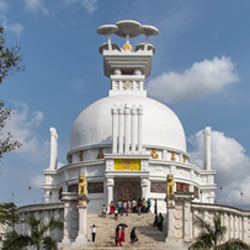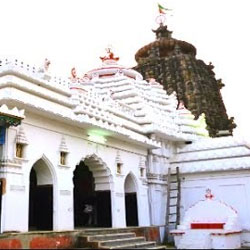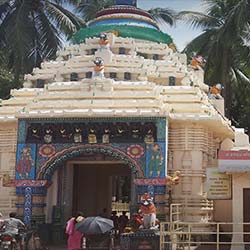
- Home
- Travel Packages
- Top Destination
-
Travel Attraction
By Category
Top Attraction

- Travel Agents
- Car Rentals
- Hotels

About Dhauli Hill, Bhubaneswar History Dhauli Hill in Bhubaneswar, Odisha, is a significant historical site that holds immense importance in Indian history. It is the location where the Kalinga War took place in 261 BC, resulting in a significant transformation in Emperor Ashoka’s life. After witnessing the devastating effects of war, Ashoka renounced violence and embraced Buddhism, leading to the spread of this peaceful religion across India. Architecture and Design The hill is adorned with a rock edict of Ashoka, depicting his conversion to Buddhism and his message of non-violence. The Shanti Stupa at Dhauli Hill is a prominent structure, symbolizing peace and harmony. The architectural design of the stupa showcases the influence of Buddhist art and culture, making it a serene and spiritually uplifting place for visitors. Best Time to Visit The best time to visit Dhauli Hill is during the winter months, between October and February. The weather during this time is pleasant, making it easier for tourists to explore the site comfortably. Additionally, the lush green surroundings of Dhauli Hill are at their most vibrant during the winter, creating a picturesque setting for visitors to enjoy. Cultural Significance Dhauli Hill holds immense cultural significance as it marks the beginning of Emperor Ashoka’s journey towards peace and non-violence. The site serves as a reminder of the destructive consequences of war and the importance of embracing compassion and harmony. The influence of Buddhism can be felt strongly at Dhauli Hill, making it a sacred place for followers of this peaceful religion. Pilgrimage Practices Pilgrims visiting Dhauli Hill often engage in spiritual practices such as meditation and prayer. They pay homage to Emperor Ashoka and seek blessings for peace and enlightenment. The peaceful ambiance of the hill makes it an ideal place for introspection and spiritual reflection, allowing pilgrims to connect with their inner selves and find solace in the teachings of Buddhism. Dress Code and Etiquette Visitors to Dhauli Hill are advised to dress modestly and respectfully, keeping in mind the sacred nature of the site. It is recommended to wear comfortable clothing and remove footwear before entering the Shanti Stupa or any other religious structures. Silence and reverence are expected from visitors to maintain the sanctity of the place and respect the spiritual beliefs of others. Activities and Experiences Visitors to Dhauli Hill can engage in a variety of activities and experiences, including exploring the rock edicts of Emperor Ashoka, admiring the intricate carvings on the Shanti Stupa, and enjoying panoramic views of the surrounding landscapes. Cultural events and festivals are also held at Dhauli Hill, providing visitors with an opportunity to immerse themselves in the rich heritage and traditions of Odisha. Art and Religious Symbols The art and religious symbols at Dhauli Hill reflect the spiritual heritage of Buddhism and the teachings of Emperor Ashoka. Intricate carvings, sculptures, and inscriptions adorn the site, depicting scenes from the life of Buddha and the message of peace and non-violence. The Shanti Stupa, in particular, is a masterpiece of Buddhist art, symbolizing the eternal quest for harmony and tranquility. Local Insights Local residents and guides offer valuable insights into the history and significance of Dhauli Hill, sharing stories and legends associated with the site. Visitors can learn about the cultural traditions of Odisha and the impact of Buddhism on the region, gaining a deeper understanding of the spiritual heritage that Dhauli Hill represents. Engaging with locals provides a unique perspective on the site and enhances the overall experience of exploring this sacred place.
Explore More
About The Lingaraj Temple The Lingaraj Temple is one of the most prominent and largest temples in Bhubaneswar, dedicated to Lord Shiva. It is a significant pilgrimage site for Hindus and attracts devotees from all over the country. The temple is a masterpiece of Kalinga architecture and is a symbol of the rich cultural heritage of Odisha. Architecture of Lingaraj Temple The Lingaraj Temple is a splendid example of ancient Kalinga architecture. The temple complex is spread over a vast area and is surrounded by numerous smaller shrines. The main sanctum sanctorum of the temple is 180 feet in height and is adorned with intricate carvings and sculptures. The temple is built using sandstone and laterite and is known for its architectural grandeur. History The Lingaraj Temple dates back to the 11th century and was built by King Jajati Keshari. The temple has undergone various renovations and additions over the centuries, but its original charm and magnificence have been preserved. The temple is a testimony to the rich cultural and religious history of Odisha and is a must-visit for history buffs and architecture enthusiasts. Best Time To Visit The best time to visit the Lingaraj Temple is during the winter months, from October to March, when the weather is pleasant and conducive for sightseeing. The temple is also thronged by devotees during festivals like Shivaratri and Kartik Purnima, so visiting during these times can provide a glimpse into the religious fervor of the place. How To Reach The Lingaraj Temple is located in the heart of Bhubaneswar, the capital city of Odisha, making it easily accessible by road, rail, and air. The Bhubaneswar Railway Station is the nearest railhead, and the Biju Patnaik International Airport is well-connected to major cities in India. Local transportation options like buses and taxis are also available for reaching the temple. Significance Of The Lingaraj Temple The Lingaraj Temple holds immense religious significance for Hindus, particularly devotees of Lord Shiva. It is believed that the Lingaraj Temple is the true abode of Lord Shiva, and a visit to the temple can bestow blessings and spiritual fulfillment. The temple is a sanctum of peace and tranquility, where devotees can offer prayers and seek solace from the chaos of everyday life. In conclusion, the Lingaraj Temple in Bhubaneswar is a treasure trove of history, culture, and spirituality. Its architectural splendor, rich history, and religious significance make it a must-visit for every traveler to Odisha. Whether you are a history buff, a religious pilgrim, or an architecture enthusiast, the Lingaraj Temple will leave you awe-inspired with its grandeur and beauty.
Explore More
About The Rajarani Temple The Rajarani Temple, located in Bhubaneswar, Odisha, is a beautiful temple dedicated to Lord Shiva and is known for its intricate architecture and stunning sculptures. The temple was built in the 11th century and is one of the lesser-known gems of Bhubaneswar. Unlike other temples in the region, the Rajarani Temple is not dedicated to a specific deity, which makes it unique in its own right. Architecture of Rajarani Temple The Rajarani Temple is known for its unique architectural style which is a blend of various influences including Dravidian, Nagara, and Kalinga styles. The temple is made of red and yellow sandstone which gives it a distinct appearance. The most striking feature of the temple is its sculpted figurines of women and couples in various erotic poses which are said to depict the celebration of love and life. History The Rajarani Temple was built in the 11th century during the rule of the Somavamsi dynasty. It is believed that the temple was originally known as Indreswara Temple before it got its current name. The temple was built as a place of worship for the royal family and it is said that the temple got its name from the red and yellow sandstone used in its construction which is locally known as "raja-rani". Best Time To Visit The best time to visit the Rajarani Temple is during the winter months from October to March when the weather is pleasant and ideal for sightseeing. The temple is open to visitors from sunrise to sunset and it is advisable to visit early in the morning or late in the evening to avoid the crowds. How To Reach The Rajarani Temple is located in Bhubaneswar, the capital city of Odisha, and is well-connected by road, rail, and air. The nearest airport is the Biju Patnaik International Airport which is located about 5 kilometers away from the temple. The temple is also easily accessible by road and there are plenty of buses and taxis available from the city center to the temple. Significance Of The Rajarani Temple The Rajarani Temple is considered to be an important heritage site in Odisha and is a popular tourist attraction. The temple is known for its unique architecture, intricate carvings, and beautiful sculptures which attract visitors from all over the world. The temple is also considered to be a place of spiritual significance and is frequented by devotees who come to seek blessings from Lord Shiva. In conclusion, the Rajarani Temple in Bhubaneswar is a must-visit destination for anyone interested in history, architecture, and spirituality. With its stunning architecture, rich history, and spiritual significance, the temple offers a unique and memorable experience for all visitors.
Explore More
About The Mukteswara Temple The Mukteswara Temple, located in Bhubaneswar, Odisha, is a renowned 10th-century Hindu temple dedicated to Lord Shiva. It is known for its exquisite architecture and intricate carvings that depict various Hindu deities, animals, and mythological figures. The temple is a fine example of Kalinga architecture and is considered a gem of Odisha's architectural heritage. Architecture of Mukteswara Temple The Mukteswara Temple is known for its distinctive architectural style, characterized by its curved tower, known as a vimana, and a porch with a sculpted doorway. The temple is adorned with intricate carvings of musicians, dancers, and divine figures, which are a testament to the skill and craftsmanship of the artisans of that era. The temple also features a unique torana, or arched gateway, decorated with ornate carvings of mythical creatures and floral motifs. History The Mukteswara Temple was built in the 10th century during the rule of the Somavamsi dynasty. It is believed to have been constructed by King Yayati I as a tribute to Lord Shiva. The temple underwent several renovations and additions over the centuries, but its original architectural integrity has remained largely intact. The Mukteswara Temple is considered a significant historical and religious site in Odisha and attracts devotees and tourists from all over the world. Best Time To Visit The best time to visit the Mukteswara Temple is during the winter months from October to March when the weather is pleasant and suitable for sightseeing. The temple is also beautifully illuminated during festivals and special occasions, making it an ideal time to witness the vibrant cultural heritage of Odisha. It is advisable to avoid visiting during the monsoon season as the heavy rains may disrupt travel and sightseeing activities. How To Reach The Mukteswara Temple is located in Bhubaneswar, the capital city of Odisha, and is easily accessible by road, rail, and air. The nearest airport is the Biju Patnaik International Airport, which is well-connected to major cities in India. Bhubaneswar Railway Station is the nearest railhead, and buses and taxis are available from the station to the temple. Local transportation options, such as auto-rickshaws and cycle rickshaws, are also available for commuting within the city. Significance Of The Mukteswara Temple The Mukteswara Temple holds great religious significance for devotees of Lord Shiva and is considered a sacred pilgrimage site. The temple is dedicated to Mukteswara, a form of Lord Shiva who is believed to grant salvation to his devotees. The intricate carvings and sculptures on the temple walls depict various Hindu deities and mythological scenes, making it a site of immense cultural and historical importance. The Mukteswara Temple is a must-visit destination for those interested in exploring the rich heritage and architectural marvels of Odisha. Overall, the Mukteswara Temple in Bhubaneswar is a magnificent architectural marvel that showcases the rich cultural heritage of Odisha and stands as a testament to the skilled craftsmanship of the artisans of that era.
Explore More
About The Sakshigopal Temple The Sakshigopal Temple, also known as the Satyabadi Gopinatha Temple, is a famous Hindu temple located in Puri, Odisha. The temple is dedicated to Lord Krishna, who is worshipped here in the form of Gopala or Gopalji. The deity of Lord Krishna in the form of a child holding a flute is the main attraction of this temple. The Sakshigopal Temple holds great religious significance among the devotees, and it is believed that the deity fulfills the wishes of the devotees who visit the temple with true devotion. Architecture of Sakshigopal Temple The architecture of the Sakshigopal Temple is a blend of Kalinga and Dravidian architectural styles. The temple is built on a raised platform with intricate carvings and sculptures adorning its walls and pillars. The main sanctum of the temple houses the idol of Lord Krishna in a standing posture, playing the flute. The temple also has a flagstaff and a flight of steps leading to the entrance. History The Sakshigopal Temple has a rich history that dates back to ancient times. It is believed that the temple was built during the medieval period by the Ganga dynasty rulers of Odisha. The temple has undergone several renovations and restorations over the centuries, but its sanctity and religious significance have remained intact. The temple is mentioned in various ancient texts and scriptures, highlighting its importance in the Hindu religious tradition. Best Time To Visit The best time to visit the Sakshigopal Temple is during the winter months from October to February when the weather is pleasant and ideal for exploring the temple complex. The temple also witnesses a large number of devotees during festivals like Janmashtami and Rath Yatra, which are celebrated with great pomp and fervor. How To Reach The Sakshigopal Temple is located in Puri, which is well-connected by road, rail, and air. The nearest airport is Biju Patnaik International Airport in Bhubaneswar, which is about 60 kilometers away from Puri. Puri Railway Station is the nearest railhead, and there are regular trains connecting Puri to major cities like Kolkata, Delhi, and Mumbai. From Puri, one can hire a taxi or take a local bus to reach the Sakshigopal Temple. Significance Of The Sakshigopal Temple The Sakshigopal Temple holds immense significance among the devotees of Lord Krishna. It is believed that the deity of Gopala in the temple is a witness to all the happenings in the world and fulfills the wishes of the devotees who visit the temple with a pure heart. The temple is also visited by newlywed couples seeking the blessings of the deity for a happy and prosperous married life. The serene and spiritual ambience of the Sakshigopal Temple makes it a must-visit destination for devotees and tourists alike. Overall, the Sakshigopal Temple in Puri is a sacred place that exudes peace and tranquility, making it a perfect destination for spiritual seekers and devotees of Lord Krishna. The rich history, magnificent architecture, and religious significance of the temple make it a popular pilgrimage site in Odisha.
Explore More
About The Gundicha Temple The Gundicha Temple, also known as the Garden House of Jagannath, is a Hindu temple located in Puri, Odisha. It is dedicated to Lord Jagannath's aunt, Gundicha. The temple is an important pilgrimage site for devotees of Lord Jagannath and is visited by thousands of people every year during the annual Rath Yatra festival. Architecture of Gundicha Temple The Gundicha Temple is built in the traditional Kalinga style of architecture, with intricate carvings and sculptures adorning its walls. The temple complex consists of a main shrine dedicated to Gundicha Devi, as well as smaller shrines dedicated to other deities. The temple is surrounded by a beautiful garden, adding to its serene ambiance. History The Gundicha Temple was built in the 16th century by Queen Gundicha, the queen of King Indradyumna. According to legend, Lord Jagannath visits the Gundicha Temple once a year during the Rath Yatra festival, as a symbolic visit to his aunt's house. The temple holds great religious significance for devotees of Lord Jagannath. Best Time To Visit The best time to visit the Gundicha Temple is during the annual Rath Yatra festival, which usually takes place in the months of June or July. During this time, the temple is beautifully decorated and devotees from all over the world come to witness the grand procession of Lord Jagannath's chariot. How To Reach The Gundicha Temple is located in the heart of Puri, making it easily accessible by road. The nearest airport is in Bhubaneswar, which is around 60 kilometers away from Puri. The temple can also be reached by train, as Puri has a well-connected railway station. Local transportation options like taxis and auto-rickshaws are available for reaching the temple. Significance Of The Gundicha Temple The Gundicha Temple holds immense significance for devotees of Lord Jagannath. It is believed that a visit to the temple during the Rath Yatra festival brings blessings and prosperity. The temple's peaceful surroundings and spiritual atmosphere make it a popular destination for those seeking solace and inner peace. In conclusion, the Gundicha Temple in Puri is not just a religious site, but a symbol of devotion and faith for millions of devotees. Its beautiful architecture, rich history, and spiritual significance make it a must-visit destination for anyone seeking to connect with the divine.
Explore More
About The Cuttack Chandi Temple The Cuttack Chandi Temple is a famous Hindu shrine located in the city of Cuttack in the eastern Indian state of Odisha. Dedicated to the goddess Chandi, who is considered to be a powerful and fierce form of Goddess Durga, the temple is one of the oldest in the region and holds great religious significance for devotees. Architecture of Cuttack Chandi Temple The architecture of the Cuttack Chandi Temple is a fine example of traditional Odisha style. The main temple structure has a distinct pyramid shape with intricate carvings on the walls depicting various mythological scenes. The temple is surrounded by a spacious courtyard with multiple smaller shrines dedicated to other deities. The entrance of the temple is adorned with beautiful sculptures and intricate designs that showcase the rich cultural heritage of the region. History The history of the Cuttack Chandi Temple dates back to ancient times. It is believed that the temple was originally built in the 14th century by the rulers of the Ganga dynasty. Over the centuries, the temple has undergone several renovations and expansions, but its core structure has remained intact. The temple is also closely associated with the Kalinga War fought by Emperor Ashoka, as it is said to have been a place of worship for the soldiers before going into battle. Best Time To Visit The best time to visit the Cuttack Chandi Temple is during the festive season of Durga Puja, which usually falls in the months of September or October. During this time, the temple is beautifully decorated with lights and flowers, and special ceremonies and rituals are conducted to honor the goddess Chandi. The atmosphere is vibrant and festive, making it an ideal time to experience the spiritual energy of the temple. How To Reach The Cuttack Chandi Temple is easily accessible by road, rail, and air. The nearest airport is Biju Patnaik International Airport in Bhubaneswar, which is approximately 30 kilometers away from Cuttack. The city is well connected by train, with regular services from major cities like Kolkata, Chennai, and Delhi. Local buses and taxis are also available for transportation within the city. Significance Of The Cuttack Chandi Temple The Cuttack Chandi Temple holds great significance for the devotees who worship the goddess Chandi. It is believed that the goddess is a protector of the city and its people, and devotees come to the temple to seek her blessings for protection, prosperity, and well-being. The temple is also popular among tourists for its architectural beauty and cultural heritage, making it a must-visit destination in Cuttack. Overall, the Cuttack Chandi Temple is a symbol of religious devotion, cultural richness, and architectural beauty, and it continues to attract visitors from far and wide who come to pay homage to the fierce goddess Chandi and experience the spiritual energy of the temple.
Explore More
About The Maa Jhanjhiri Mangala Temple The Maa Jhanjhiri Mangala Temple is a highly revered Hindu temple located in Cuttack, Odisha. It is dedicated to Goddess Mangala, also known as Maa Jhanjhiri, who is believed to be an incarnation of Goddess Durga. The temple is a popular pilgrimage site for devotees who come to seek the blessings of the goddess and offer their prayers. Architecture of Maa Jhanjhiri Mangala Temple The Maa Jhanjhiri Mangala Temple is known for its stunning architecture and intricate carvings. The temple stands tall with its beautiful spire and is adorned with colorful paintings and sculptures of various Hindu deities. The sanctum sanctorum houses the idol of Goddess Mangala, which is beautifully decorated with flowers and ornaments by the temple priests. The temple complex also includes smaller shrines dedicated to other deities, adding to the spiritual ambiance of the place. History The history of the Maa Jhanjhiri Mangala Temple dates back several centuries. It is believed that the original temple was built during the reign of the Ganga dynasty in the region. Over the years, the temple has undergone renovations and additions, resulting in the magnificent structure that stands today. The temple has withstood the test of time and continues to attract devotees from far and wide who come to pay their respects to the goddess. Best Time To Visit The best time to visit the Maa Jhanjhiri Mangala Temple is during the festival of Durga Puja, which is celebrated with great enthusiasm and fervor in Cuttack. The temple is beautifully decorated during this time, and devotees throng the temple to participate in the festive celebrations. Apart from Durga Puja, other auspicious occasions like Navratri and Diwali also see a large number of visitors at the temple. How To Reach The Maa Jhanjhiri Mangala Temple is easily accessible by road from various parts of Cuttack and neighboring cities. It is located in the heart of the city, making it convenient for pilgrims to reach the temple. Buses and taxis are available for transportation to the temple, and the nearest railway station is also just a short distance away. For those traveling from afar, the Biju Patnaik International Airport in Bhubaneswar is the nearest airport to reach Cuttack. Significance Of The Maa Jhanjhiri Mangala Temple The Maa Jhanjhiri Mangala Temple holds great significance in the hearts of devotees who believe that worshipping the goddess brings prosperity, protection, and blessings. The temple is a place of solace and spiritual rejuvenation for many who seek guidance and divine intervention in their lives. The idol of Goddess Mangala is considered to be extremely powerful, and devotees offer prayers and perform rituals to seek her blessings for their well-being and prosperity. Overall, the Maa Jhanjhiri Mangala Temple is a symbol of faith, devotion, and spirituality for the people of Cuttack and beyond.
Explore MoreExplore Puri Jagannath DhamTour
5 Days/ 4 Night
Puri - Bhubaneswar
6N 7D Kolkata - Gangasagar - Bhubaneswar - Puri Tour
7 Days/ 6 Night
Bhubaneswar - Puri - Kolkata
Gopalpur Daringibadi
5 Days/ 4 Night
Gopalpur
6 Nights - 7 Days West Bengal Tour From Kolkata
7 Days/ 6 Night
Bhubaneswar - Konark - Puri - Kolkata